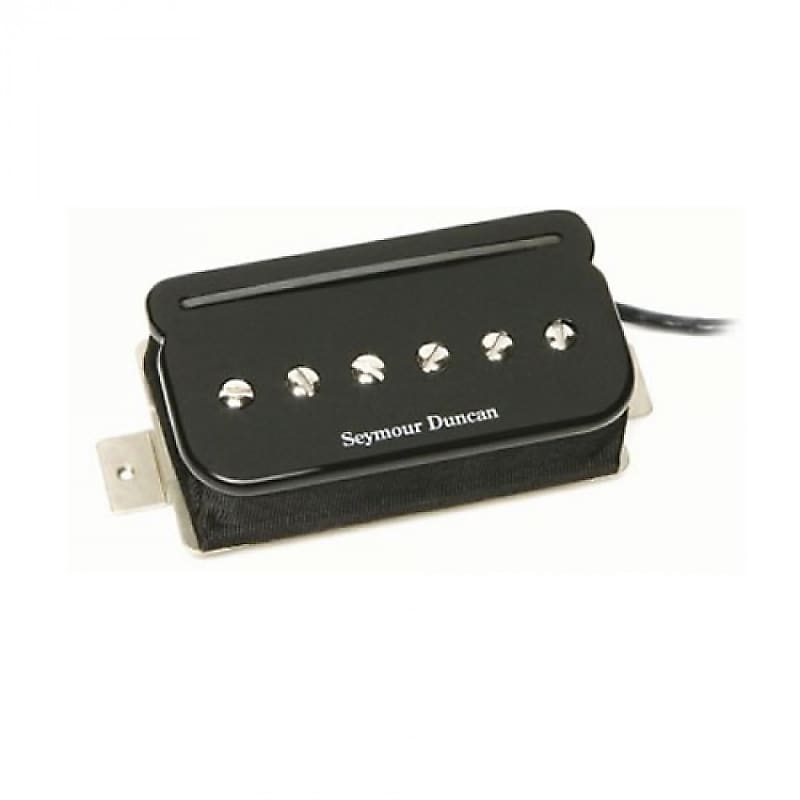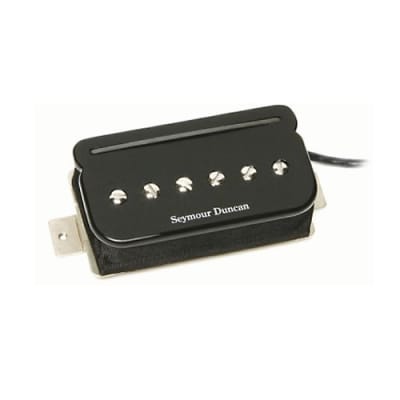


SEYMOUR DUNCAN P-Rails TBPR-1b P-90 Trembucker Bridge Pickup, Black
Price$119
Free Shipping
from Torrance, CA
Listed:over a month ago
Views:533
Watchers:5

Torrance, CA, United States
30-Day Return Policy
Enjoy peace of mind with your new gear



Free Shipping
from Torrance, CA

30-Day Return Policy
Enjoy peace of mind with your new gear
The Seymour Duncan TBPR-1b is the Trembucker (f-spaced) version of the popular SHPR-1b P-Rails pickup. This pickup is designed for guitars with string spacing of greater than 2 inches at the bridge. Pole spacing is approx. 2.070" (about 2 1/16").
Until now, if you wanted humbucker, P-90, and vintage Strat tones, you'd have to haul three guitars to the gig. Enter P-Rails. It's a full-size humbucker that splits to either a full-size P-90 or a special Alnico-powered single-coil Rail pickup. The humbucker sound is full and expansive, owing to the mis-matched coil configuration. The P-90 is a super fat. And the Rail coils, when used together, sound like the "2" and "4" positions in a great Strat.
P-Rails are best used in a matched neck and bridge set. To get both humbucker and P-90 tones, use a two-way switch (push-pull or mini-toggle). To have humbucker and P-90 tones and bring in the added dimension of the single-coil Rail, use a three-way switch (DPDT on-off-on). P-Rails can be used in any guitar set up for a traditional humbucker or Trembucker. A single P-Rails will bring added dimension to your guitar. However, to optimize the P-Rails unique splitting capabilities and get the best single-coil Rails tones, use a neck and bridge set.
Normally, in humbucking mode, P-Rails are wired in series, for a high-output sound that works great for classic rock and heavier tones. However, when wired in parallel, the coil mismatch produces a very usable P.A.F.-style humbucker tone with less phase cancellation associated with standard parallel wired humbuckers, complete with present upper-mid "bloom" and pronounced string articulation.
| Condition | |
| Brand | |
| Model |
|
| Finish |
|
| Categories | |
| Year |
|

The Seymour Duncan TBPR-1b is the Trembucker (f-spaced) version of the popular SHPR-1b P-Rails pickup. This pickup is designed for guitars with string spacing of greater than 2 inches at the bridge. Pole spacing is approx. 2.070" (about 2 1/16").
Until now, if you wanted humbucker, P-90, and vintage Strat tones, you'd have to haul three guitars to the gig. Enter P-Rails. It's a full-size humbucker that splits to either a full-size P-90 or a special Alnico-powered single-coil Rail pickup. The humbucker sound is full and expansive, owing to the mis-matched coil configuration. The P-90 is a super fat. And the Rail coils, when used together, sound like the "2" and "4" positions in a great Strat.
P-Rails are best used in a matched neck and bridge set. To get both humbucker and P-90 tones, use a two-way switch (push-pull or mini-toggle). To have humbucker and P-90 tones and bring in the added dimension of the single-coil Rail, use a three-way switch (DPDT on-off-on). P-Rails can be used in any guitar set up for a traditional humbucker or Trembucker. A single P-Rails will bring added dimension to your guitar. However, to optimize the P-Rails unique splitting capabilities and get the best single-coil Rails tones, use a neck and bridge set.
Normally, in humbucking mode, P-Rails are wired in series, for a high-output sound that works great for classic rock and heavier tones. However, when wired in parallel, the coil mismatch produces a very usable P.A.F.-style humbucker tone with less phase cancellation associated with standard parallel wired humbuckers, complete with present upper-mid "bloom" and pronounced string articulation.
| Condition | |
| Brand | |
| Model |
|
| Finish |
|
| Categories | |
| Year |
|
Your purchases help youth music programs get the gear they need to make music.
Your purchases also help protect forests, including trees traditionally used to make instruments.